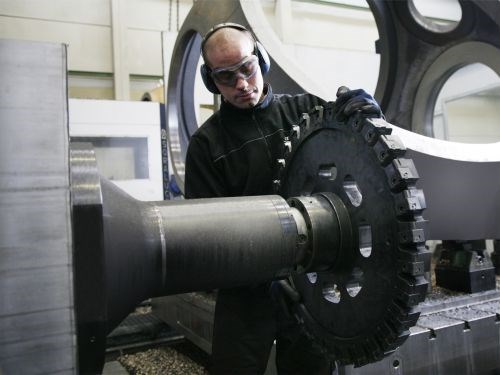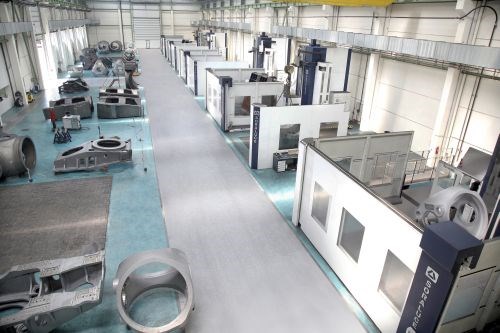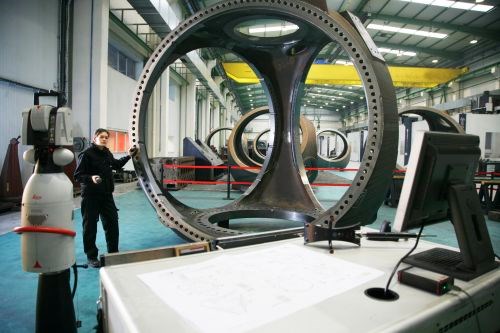Startup Leverages Machine Tool Builder Expertise
To improve competitiveness, Sakana, a gray and ductile iron casting firm, decided to take responsibility for more steps in the wind turbine manufacturing process. With no experience in machining, partnering with machine tool builder Soraluce was key to the success of a new facility dedicated to machining frames and hubs.
Share




Takumi USA
Featured Content
View More


Hwacheon Machinery America, Inc.
Featured Content
View More

Although seeking to add more value as a supplier is certainly not uncommon for manufacturers, wind turbine component manufacturer Lakber might be considered an extreme example. Founded in 2008 near Pamplona in northern Spain, the firm is the first venture by iron-casting parent company Sakana into machining and painting, a response to OEM customers who suggested that the company perform more of the manufacturing process in-house. With no experience in either field, the iron casting company needed more than just a machine tool vendor that could supply the proper equipment. Moving into wind turbine component machining would require a dedicated, experienced partner that could provide the necessary expertise to start a completely new operation from scratch.
The company found that partner in boring mill manufacturer Soraluce, part of the Danobat Group. “In two years, we have turned a written project into one of the most reliable hub and frame manufacturers in the world-- That is the feedback we get from customers when they come to visit,” says Alejandro Martinez, general manager at Lakber.
While taking responsibility for more steps in the manufacturing process would certainly benefit the gray and ductile iron casting company’s competitiveness, doing so would require an investment of more than 20 million Euros. After considering other options, such as subcontracting such work to third parties, Sakana decided that gaining the flexibility to adapt to customers’ changing production requirements and realizing the cost efficiencies of integrating all processes in the same industrial area would make the investment well worth it. So a new facility was planned, one that would incorporate its own 16,000-ton-per-year capacity foundry dedicated exclusively to wind energy components. The original foundry, also with a 16,000-ton capacity, would be free to focus on smaller wind turbine parts as well as the machine tool, marine engine and other sectors.
Soraluce’s expertise in turn-key projects was a critical factor in defining the general requirements for new machines and accessories and even in rationalizing the layout of the plant. “They provided us with the boring mills, the fixturing, the machining process, the cutting tools advice, the NC machining programs and more—in addition to ‘field knowledge’ that can only be obtained through a great deal of experience in providing these kinds of solutions,” Mr. Martinez says. “From the very beginning of the project, we have had a simultaneous engineering collaboration in order to update the knowledge of Lakber from almost zero to a key position in hub and frame machining knowledge for our customers from all over the world.”
The company’s primary equipment includes 5 boring mills with X, Y and Z axis travels measuring 14,000 by 5,000 by 1,600 mm. These machines incorporate spindle heads developed specifically for wind turbine machining as well as automatic head changing systems. Each incorporates two working stations with fully automatic rotary tables, an automatic tool-changing system, coolant-through-spindle capability and various part and tool probes. Lakber also invested in approximately 400 standard and custom cutting tools and a laser-tracker device from LEICA.
Producing components that range in size from 8 to 24 tons and involve removing as much as 2 tons of material is nothing to be taken lightly—the cost of a single rejected part could equal months of profits. Lakber cites a number of key technologies that not only ensure the process is as reliable as possible, but also takes saves time for employees who can then focus on more value-added activities. These include an “intelligent” cutting tool magazine with a presetter connected to every machine; a self-developed ERP system that helps control production costs, manage machine workloads and ease planning; software that connects to the general tool magazine and the magazine of each machine to help operators avoid spending time looking for lost tools; and a measuring system connected to a database that generates checklist sheets for every component and customer.
Lakber cites an influx of customers from all over the world as evidence that the investment required at start-up has paid off. Most commercial relations with customers begin with machining a pre-series of some components to determine the reliability of the process. Additionally, the shop notes that processes must not only meet tolerance, finish and other requirements, but also enable a competitive cycle time. Mr. Martinez says this requires a trained and motivated team that is dedicated to continuous improvement, which he credits for the company’s achievements thus far. In fact, processes were approved for 10 prototype components in its first year alone.
Nonetheless, Soraluce’s equipment—and, perhaps more importantly, expertise—was critical in getting the new facility off the ground. “Even if you recruit highly-trained people with a great deal of machining experience, you still need a real partner beside you,” Mr. Martinez says. “In our case, this was an essential condition because of our being a new company without any experience in his field. That’s why the technical responsibility of the machining process fell to Soraluce.”
Related Content
CNC Machine Shop Honored for Automation, Machine Monitoring
From cobots to machine monitoring, this Top Shop honoree shows that machining technology is about more than the machine tool.
Read MoreLean Approach to Automated Machine Tending Delivers Quicker Paths to Success
Almost any shop can automate at least some of its production, even in low-volume, high-mix applications. The key to getting started is finding the simplest solutions that fit your requirements. It helps to work with an automation partner that understands your needs.
Read More4 Commonly Misapplied CNC Features
Misapplication of these important CNC features will result in wasted time, wasted or duplicated effort and/or wasted material.
Read More5 Tips for Running a Profitable Aerospace Shop
Aerospace machining is a demanding and competitive sector of manufacturing, but this shop demonstrates five ways to find aerospace success.
Read MoreRead Next
Building Out a Foundation for Student Machinists
Autodesk and Haas have teamed up to produce an introductory course for students that covers the basics of CAD, CAM and CNC while providing them with a portfolio part.
Read More5 Rules of Thumb for Buying CNC Machine Tools
Use these tips to carefully plan your machine tool purchases and to avoid regretting your decision later.
Read MoreRegistration Now Open for the Precision Machining Technology Show (PMTS) 2025
The precision machining industry’s premier event returns to Cleveland, OH, April 1-3.
Read More







































.jpg;maxWidth=300;quality=90)











